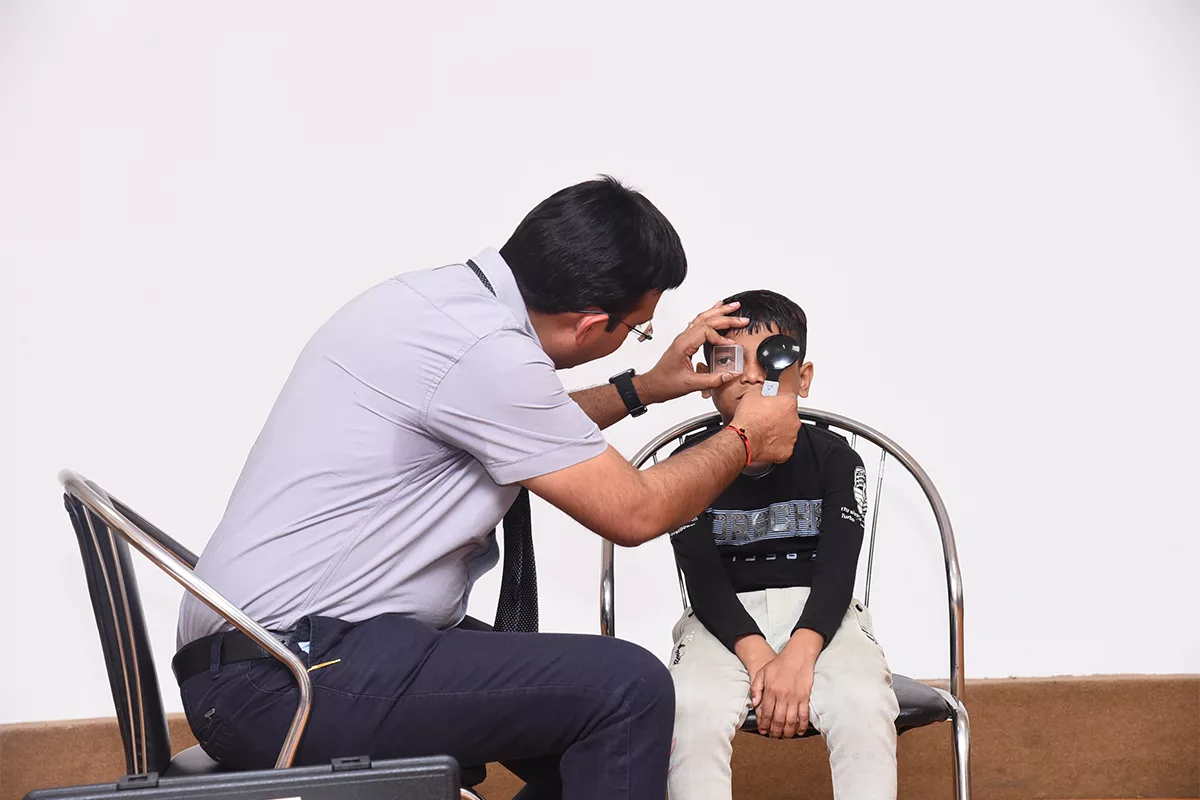NIH-funded study shows less diabetic retinopathy progression among those who underwent intensive glycemic control
 People with type 2 diabetes who intensively controlled their blood sugar level during the landmark ‘Action to Control Cardiovascular Risk in Diabetes’ (ACCORD) Trial Eye Study were found to have cut their risk of diabetic retinopathy in half in a follow-up analysis conducted four years after stopping intensive therapy. Investigators who led the ACCORD Follow-on Eye Study (ACCORDION) announced the results in New Orleans at the American Diabetes Association annual meeting. The study was supported by the National Institutes of Health’s National Eye Institute (NEI).
People with type 2 diabetes who intensively controlled their blood sugar level during the landmark ‘Action to Control Cardiovascular Risk in Diabetes’ (ACCORD) Trial Eye Study were found to have cut their risk of diabetic retinopathy in half in a follow-up analysis conducted four years after stopping intensive therapy. Investigators who led the ACCORD Follow-on Eye Study (ACCORDION) announced the results in New Orleans at the American Diabetes Association annual meeting. The study was supported by the National Institutes of Health’s National Eye Institute (NEI).
“This study sends a powerful message to people with type 2 diabetes who worry about losing vision,” said Emily Chew, M.D., Deputy Director of the NEI Division of Epidemiology and Clinical Applications and lead author of the study report, published online in Diabetes Care. “Well-controlled glycemia, or blood sugar level, has a positive, measurable and lasting effect on eye health.”
A complication of diabetes, diabetic retinopathy can damage tiny blood vessels in the retina- the light-sensitive tissue in the back of the eye. ACCORDION is a follow-up assessment of diabetic retinopathy progression in 1,310 people who participated in ACCORD, which tested three treatment strategies to reduce the risk of cardiovascular disease among people with longstanding type 2 diabetes. ACCORD tested by maintaining near-normal blood sugar levels (intensive glycemic control); improving blood lipid levels, such as lowering LDL ‘bad’ cholesterol and triglycerides as well as raising HDL ‘good’ cholesterol; and lowering blood pressure.
The treatment phase of the glycemic control portion of ACCORD had been planned to last 5.6 years but was stopped at 3.5 years due to an increase in death among participants in the intensive glycemic control group. The blood pressure and blood lipid portions of ACCORD continued. Tight control successfully reduced glycemia to an average 6.4 percent A1C—a measure of average blood glucose—compared to 7.7 percent among participants on standard glycemic control therapy.
Although it failed to reduce cardiovascular disease risk, such as heart attack and stroke, the researchers found that the therapy had cut retinopathy progression by about one-third by the end of ACCORD.
Investigators considered progression to have occurred if a participant required laser surgery for diabetic retinopathy, or required a vitrectomy—a procedure used to remove the gel-like fluid of the eye—or advanced three or more steps on the Early Treatment Diabetic Retinopathy Study (ETDRS) Severity Scale. The ETDRS Severity Scale uses photographs of the retina to rate disease severity from 1 (no disease) to 17 (high-risk for progression in both eyes).
ACCORDION re-assessed diabetic retinopathy about four years after the intensive glycemic control portion of the study had ended—eight years after enrollment in ACCORD. By then, average A1C was nearly the same: 7.8 percent for the intensive therapy group and 7.9 percent for the standard therapy group.
However, diabetic retinopathy had advanced in only 5.8 percent of participants in the intensive therapy group since enrollment in ACCORD, compared to 12.7 percent in the standard therapy group. “Despite this equalisation of glycemic control in the two groups, there continued to be an approximately 50 percent risk reduction of further retinopathy progression, a phenomenon termed metabolic memory,” said Frederick L. Ferris III, M.D., NEI Clinical Director, who was not involved in the study.
Other clinical trials have reported the phenomenon, also known as the legacy effect. Participants with type 1 diabetes who received intensive glycemic therapy in the 10-year-long Diabetes Control and Complications Trial on average had 50 percent less progression of diabetic retinopathy three decades later. A similar trend was seen in the United Kingdom Prospective Diabetes Project, a study of people with newly diagnosed type 2 diabetes.
Results from ACCORDION suggests that lowering blood glucose can reduce progression of retinal disease relatively late in the course of type 2 diabetes and that even short-term changes in glucose have an effect.
The findings add to mounting evidence that tight glycemic control has positive, long-lasting effects on small blood vessels.
Other follow-up studies of ACCORD participants have observed a legacy effect similar to ACCORDION in kidney and peripheral nerve health, which also involves small blood vessels.
 But the benefits of intensive glycemic therapy must be weighed against the potential risks- most notably the increased risk of death observed in ACCORD. Investigators have been unable to determine a cause for the increase, which was not seen in other trials.
But the benefits of intensive glycemic therapy must be weighed against the potential risks- most notably the increased risk of death observed in ACCORD. Investigators have been unable to determine a cause for the increase, which was not seen in other trials.
Results also point to a possible role for ongoing use of fenofibrate to treat diabetic retinopathy, if taken regularly. The blood lipid and blood pressure portions of ACCORD concluded at 5.6 years. Neither strategies reduced cardiovascular disease.
However, fenofibrate, a drug that raises HDL cholesterol, decreased diabetic retinopathy progression by about one-third during ACCORD. ACCORDION investigators found fenofibrate had no lasting benefit 3 years after the drug was discontinued. But based on ACCORD findings, fenofibrate might be worth taken to control diabetic retinopathy progression. Other countries, including Australia, have approved fenofibrate for treating diabetic retinopathy but not the U.S., said Chew.
The NEI-funded Diabetic Retinopathy Clinical Research Network is currently planning a clinical trial to further explore ongoing use of fenofibrate to control diabetic retinopathy.
Diabetic retinopathy affects about 7.7 million Americans and is the leading cause of vision loss among working-age Americans. Diabetic retinopathy can cause blood vessels to swell and leak fluid, sometimes distorting vision.
Proliferative diabetic retinopathy, an advanced stage of the disease, occurs when abnormal blood vessels appear on the surface of the retina. These abnormal blood vessels are prone to bleeding and lead to the formation of scar tissue, sometimes causing retinal detachment and permanent vision loss.
The new research points towards the importance of proper vision care for diabetic patients and once again underlines the importance of regular examinations to maintain healthy eyesight in the long run.
Eye Care For Diabetics
Here are some Eye Care tips for diabetics
 Scheduling regular check-ups with an eye doctor at least once a year so as to detect any problem early on and treat it.
Scheduling regular check-ups with an eye doctor at least once a year so as to detect any problem early on and treat it.
Keeping blood sugar and blood pressure under check at all times. Sugar and BP can aggravate conditions, hence consulting the doctor on how to manage it is a must.
Keeping a tab on the cholesterol levels. All it takes is a blood test to find out how much ‘bad’ LDL and ‘good’ HDL cholesterol one has.
Eat right and stay fit. A diabetic patient must opt for healthy foods like fruits, vegetables, whole grains and lean proteins, as well as exercising for a well balanced lifestyle. One can ask their doctor to know what type of workout suits their condition.
Lastly, if the diabetic patient is a smoker, this is a habit he/she will have to quit. It’s not easy to kick the habit, but with help one can tackle the problem effectively.












